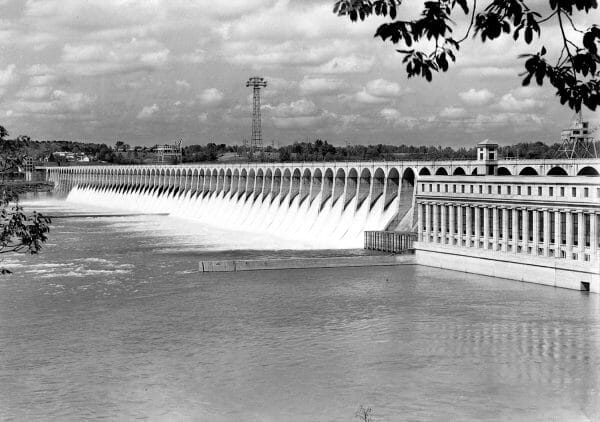Tennessee Valley Authority in Alabama
The Tennessee Valley Authority (TVA) is the nation’s largest public power company and a world-renowned regional development agency. It operates hydroelectric dams and coal-fired and nuclear power plants in northern Alabama, Georgia, Kentucky, Mississippi, North Carolina, Tennessee, and Virginia. TVA also manages the Tennessee River for flood control, navigation, recreation, and water quality. Created by the U.S. Congress on May 18, 1933, TVA is one of only a handful of federal agencies surviving from the New Deal era. Its headquarters are in Knoxville, Tennessee.
TVA’s origins can be traced to the nineteenth century and desires to tame the Tennessee River. Its series of hazards, including Alabama’s famous Muscle Shoals, made many stretches of the river channel unnavigable. In addition, winter and spring rains often caused the river to flood its banks, resulting in property damage and soil erosion throughout the region. The valley achieved national exposure with the U.S. entry into World War I. Congress, fearing that imported nitrates crucial to the production of explosives would be limited by German naval operations, authorized the immediate construction of two nitrate plants powered by an adjacent hydroelectric facility, Wilson Dam. Government engineers selected Muscle Shoals as the construction site because it had the most potential for the development of water power east of the Rocky Mountains, but the war ended before the facilities could begin production.
For the next 15 years, Congress struggled over what to do with the $130 million complex. Because hydroelectric power could be used to promote economic development and the nitrates could be used to produce fertilizer, lawmakers proposed shifting its purpose from national defense to domestic production. Henry Ford, among other private interests, hoped to purchase the facility but were opposed by Nebraska senator George W. Norris, who believed the government should unify and control the development of natural resources. The idea that individual resources should be managed as one unified resource became the foundation of the TVA Act, signed into law in 1933.
TVA was a boon for the people in the region. At this time, only three percent of farms in the Tennessee Valley had electricity. About half of the residents were on public relief, per capita income was half the national average, the birthrate was one-third higher than the national average, literacy levels were low, and the labor force was largely unskilled. In addition, outdated farming practices had depleted the soil and caused erosion, poor logging practices had nearly denuded vast forests, and unchecked fires burned 10 percent of the region’s remaining woodlands every year.
 Tennessee Valley Authority Chemical Plant, 1942
Following the principles of unified resource development, Congress gave TVA a broad mandate: to regulate the flow of the Tennessee River system to create a deep-water navigation channel and to regulate flood waters in the Tennessee and lower Mississippi valleys. As a by-product of building dams to control floods, TVA also would produce inexpensive electrical power. The agency would provide for reforestation and agricultural and industrial development of the valley. The operation of experimental chemical plants for developing new fertilizer materials and for manufacturing munitions in times of national emergency remained an important facet of TVA’s mission. In addition, TVA was charged with conserving and developing the natural resources in the Tennessee River basin. A three-member board was appointed to lead the agency by the government.
Tennessee Valley Authority Chemical Plant, 1942
Following the principles of unified resource development, Congress gave TVA a broad mandate: to regulate the flow of the Tennessee River system to create a deep-water navigation channel and to regulate flood waters in the Tennessee and lower Mississippi valleys. As a by-product of building dams to control floods, TVA also would produce inexpensive electrical power. The agency would provide for reforestation and agricultural and industrial development of the valley. The operation of experimental chemical plants for developing new fertilizer materials and for manufacturing munitions in times of national emergency remained an important facet of TVA’s mission. In addition, TVA was charged with conserving and developing the natural resources in the Tennessee River basin. A three-member board was appointed to lead the agency by the government.
TVA acquired the government facilities at Muscle Shoals and began producing phosphate fertilizers at the former nitrate production facilities. Partnering with state land-grant institutions, including Auburn University and the University of Tennessee, TVA transformed valley agriculture, reduced soil erosion, increased crop yields, and advanced agricultural diversification. From 1933 until the 1980s, TVA operated a comprehensive fertilizer research and development program at Muscle Shoals, the Agricultural Resource Development Program, which was expanded to improve agriculture throughout the nation. TVA’s National Fertilizer Development Center was one of the agency’s successful initiatives. TVA conducted demonstrations to introduce new and improved TVA fertilizers and agricultural practices on about 90,000 farms throughout the nation as well as Puerto Rico.
 Generator Units at Wilson Dam
Also under the TVA Act, the agency acquired Wilson Dam in 1933. Constructed in Colbert County between 1918 and 1925 by the U.S. War Department, Wilson Dam was important to another element of TVA’s mission: creating and maintaining a navigable river channel. By 1936, the agency had adopted a plan for the unified development of the Tennessee River through a system of nine main-river locks and dams that would provide navigation and flood control. Wheeler Dam, constructed between 1933 and 1936 in Lauderdale County, was the first main-river dam and reservoir built. In 1939, Guntersville Dam in Marshall County completed TVA’s main river construction on the Alabama portion of the Tennessee River. By 1939, when the agency completed Guntersville Dam, a six-foot deep channel was available from Paducah, Kentucky, to Chattanooga, Tennessee. River traffic, consisting of barges hauling grain and forest and petroleum products, had increased more than three-fold between 1933 and 1939. By 1945, the Tennessee River was fully navigable from Paducah to Knoxville, Tennessee, at the full navigable depth of nine feet.
Generator Units at Wilson Dam
Also under the TVA Act, the agency acquired Wilson Dam in 1933. Constructed in Colbert County between 1918 and 1925 by the U.S. War Department, Wilson Dam was important to another element of TVA’s mission: creating and maintaining a navigable river channel. By 1936, the agency had adopted a plan for the unified development of the Tennessee River through a system of nine main-river locks and dams that would provide navigation and flood control. Wheeler Dam, constructed between 1933 and 1936 in Lauderdale County, was the first main-river dam and reservoir built. In 1939, Guntersville Dam in Marshall County completed TVA’s main river construction on the Alabama portion of the Tennessee River. By 1939, when the agency completed Guntersville Dam, a six-foot deep channel was available from Paducah, Kentucky, to Chattanooga, Tennessee. River traffic, consisting of barges hauling grain and forest and petroleum products, had increased more than three-fold between 1933 and 1939. By 1945, the Tennessee River was fully navigable from Paducah to Knoxville, Tennessee, at the full navigable depth of nine feet.
Flood control was another TVA priority. The reservoirs created by the TVA dams allowed for more than one million acre-feet of controlled storage for flood waters in Alabama alone, and since its inception, TVA’s system of multipurpose dams and reservoirs has saved more than $5.8 billion in estimated damages in the region.
The dams also supported the congressional mandate to promote the use of electricity on farms and in rural areas. In 1934, only 1 in 30 Alabama farms had electricity; by 1939 this number had increased to 1 in 7. At the time of their initial service, the Wilson, Wheeler, and Guntersville dams generated a total of 487,300 kilowatts, a little more than half of TVA’s total generation capacity. TVA’s power supply grew as it acquired sites from other power entities, most notably Alabama Power Company properties in north Alabama for $4.2 million in July 1940, thus expanding its customer base to more than 400,000. The establishment of electric cooperatives by the people in the area, the development of low-cost rural lines, and financing provided by the Rural Electrification Administration were other important factors contributing to the growth of rural electrification.
 Colbert Fossil Plant
At the outbreak of World War II, TVA’s power system was the largest in the South and one of the 10 largest in the country. The agency immediately became an important resource in the war effort, but to provide additional electric power for war industries, it undertook one of the largest construction programs ever in the United States. At its wartime peak in 1942, TVA was building 12 hydroelectric projects and the Watts Bar Steam Plant. At war’s end, the TVA system was producing nearly 12 billion kilowatt hours of electricity annually, with 8 billion kilowatts devoted to war-related industries.
Colbert Fossil Plant
At the outbreak of World War II, TVA’s power system was the largest in the South and one of the 10 largest in the country. The agency immediately became an important resource in the war effort, but to provide additional electric power for war industries, it undertook one of the largest construction programs ever in the United States. At its wartime peak in 1942, TVA was building 12 hydroelectric projects and the Watts Bar Steam Plant. At war’s end, the TVA system was producing nearly 12 billion kilowatt hours of electricity annually, with 8 billion kilowatts devoted to war-related industries.
TVA used the Muscle Shoals facilities once again for defense industries. More than 60 percent of the phosphorus required for a wide variety of bombs, shells, bullets, and other munitions was produced at Muscle Shoals. TVA also delivered nearly 30,000 tons of anhydrous ammonia, 10,000 tons of ammonium nitrate liquor, and 64,000 tons of ammonium nitrate crystal to the U.S. Ordnance Department. The agency produced more than 200,000 tons of calcium carbide used to manufacture synthetic rubber, employing rehabilitated equipment from World War I. The TVA Muscle Shoals facilities also manufactured temporary housing and trained military officials for malaria control. In addition, TVA’s system of locks and channels enabled federal ship-building efforts to construct ocean-going vessels such as Liberty cargo ships and patrol torpedo boats at inland shipyards as far north as Decatur.
After the war, the agency continued to contribute to Alabama’s economy and prosperity. TVA reservoirs promoted recreation, and TVA land helped initiate Alabama’s state park system. In 1947, it transferred 4,000 acres of land to the state for Little Mountain State Park on Guntersville Reservoir and in 1952 transferred 1,981 acres for the creation of Joe Wheeler State Park. The agency charged an average of 1.35 cents per kilowatt-hour compared with approximately 2.78 cents per kilowatt-hour nationally, drawing manufacturers and other employers to the region. From 1929 to 1950, manufacturing employment in the region grew from 222,000 jobs to 382,000. In roughly the same period, income received by individuals from manufacturing in the Tennessee Valley region increased by 442 percent compared with the national average of 282 percent.
 Browns Ferry Nuclear Power Plant
By the early 1950s, the demand for electricity was outpacing capacity, so TVA began building coal-fired steam plants, such as Widows Creek and Colbert in north Alabama. As of 1955, coal had surpassed hydroelectric as the system’s primary power source. When the public became concerned with the environmental issues related to the use of coal, TVA turned to nuclear power and completed its first nuclear plant, Browns Ferry near Athens, in 1974. Public concerns about the safety of nuclear energy, however, along with ebbing demand, rising costs, and management problems, prompted TVA to postpone and ultimately cancel several nuclear plants. Ironically, concerns related to coal emissions led to a revival of the nuclear program in 2007, with the restart of Browns Ferry Unit 1, the first nuclear reactor to come online in the United States in more than a decade.
Browns Ferry Nuclear Power Plant
By the early 1950s, the demand for electricity was outpacing capacity, so TVA began building coal-fired steam plants, such as Widows Creek and Colbert in north Alabama. As of 1955, coal had surpassed hydroelectric as the system’s primary power source. When the public became concerned with the environmental issues related to the use of coal, TVA turned to nuclear power and completed its first nuclear plant, Browns Ferry near Athens, in 1974. Public concerns about the safety of nuclear energy, however, along with ebbing demand, rising costs, and management problems, prompted TVA to postpone and ultimately cancel several nuclear plants. Ironically, concerns related to coal emissions led to a revival of the nuclear program in 2007, with the restart of Browns Ferry Unit 1, the first nuclear reactor to come online in the United States in more than a decade.
Since 1959, TVA had been self-sustaining by selling electricity to its customers throughout the Tennessee Valley, using no tax dollars for power operations. By the early 1980s, critics were depicting TVA as an off-track and bloated bureaucratic agency. Like most of the country, the agency was struggling with an economic recession. Former Ford and Nissan executive Marvin Runyon was named chairman in 1988 and brought his business management practices to the agency. Under Runyon, TVA began to transition from a regional bureaucracy to a more competitive, efficient, and focused government-owned corporation. Power rates were kept constant, overhead expenses were cut, and a total quality initiative helped the agency focus on customer satisfaction.
The end of the twentieth century brought additional changes to TVA. In October 1997, Congress directed the agency to fund essential stewardship activities, such as management of the Tennessee River system and TVA properties, with power funds in the event that there were insufficient appropriations or other available funds to pay for such activities in any year. Since 2000, Congress has not provided any funds to TVA for such activities. In 2005, Congress amended the TVA Act, changing TVA’s governance structure from a three-member, full-time board of directors to a nine-member, part-time board, which assumed its duties on March 31, 2006. One of its first actions was to name Tom Kilgore, an energy company executive, as TVA’s first president and chief executive officer.
 TVA Power Lines in Huntsville
Into the twenty-first century, TVA remains an important component in the state’s economy and in the lives of its residents. It supplies power to 16 north Alabama counties, a service area of 8,360 square miles, serving 461,000 Alabama households as well as many of the state’s largest industrial, commercial, and governmental employers. In 2007 alone, the agency supplied 18.5 billion kilowatt hours of electricity to 17 municipalities and eight cooperatively owned Alabama power companies. Within the state, the agency operates three hydroelectric dams, two coal-fired power plants, one combustion turbine site, and a nuclear facility.
TVA Power Lines in Huntsville
Into the twenty-first century, TVA remains an important component in the state’s economy and in the lives of its residents. It supplies power to 16 north Alabama counties, a service area of 8,360 square miles, serving 461,000 Alabama households as well as many of the state’s largest industrial, commercial, and governmental employers. In 2007 alone, the agency supplied 18.5 billion kilowatt hours of electricity to 17 municipalities and eight cooperatively owned Alabama power companies. Within the state, the agency operates three hydroelectric dams, two coal-fired power plants, one combustion turbine site, and a nuclear facility.
In Alabama, TVA either owns or maintains 77 substations and 2,364 circuit miles of transmission lines. It manages six locks serving 60 ports and terminals that facilitate the transport of about 15 million tons of cargo annually. Nearly 2,800 individuals are employed by the TVA in Alabama, which is home to more than 4,400 TVA retirees and their families. Since 1995, TVA has invested nearly $32.2 million in economic-development loans for new and expanding industries that have helped create approximately 10,440 new jobs in the state. TVA also manages and maintains eight reservoirs with nearly 3,000 miles of shoreline and 90,000 acres of public land. These holdings not only provide power and flood protection to local residents; they also endow them with fishing, boating, and other recreational activities.
For many residents, the success of TVA was measured not in kilowatts or concrete, but in better jobs and an improved quality of life recorded not only by massive dams and expansive reservoirs, but also by good wages, secure retirements, and productive farms.
Further Reading
- Ezzell, Patricia Bernard. TVA Photography: Thirty Years of Life in the Tennessee Valley. Jackson: University Press of Mississippi, 2003.
- ———. TVA Photography, 1963-2008: Challenges and Changes in the Tennessee Valley. Jackson: University Press of Mississippi, 2008.
- Hargrove, Erwin C. and Paul K. Conkin, ed. TVA: Fifty Years of Grass Roots Bureaucracy. Urbana: University of Illinois Press, 1983.
- Hubbard, Preston J. Origins of the TVA: The Muscle Shoals Controversy, 1920-1932. Nashville: Vanderbilt University Press, 1961.
- Martin, Roscoe C., ed. TVA, The First Twenty Years: A Staff Report. Tuscaloosa: University of Alabama Press, 1956.
- Owen, Marguerite. The Tennessee Valley Authority. New York: Praeger, 1973.





